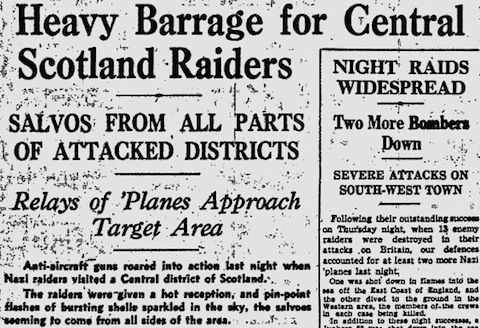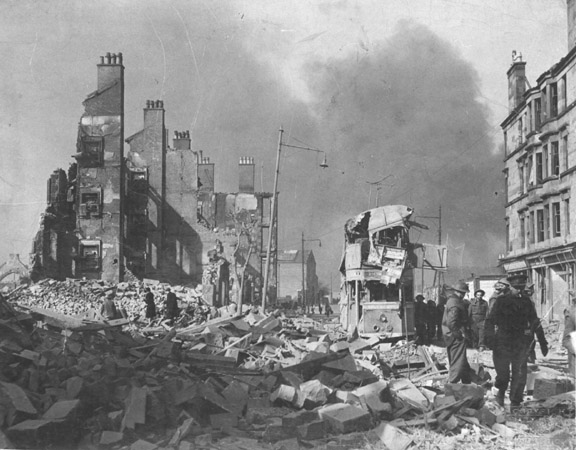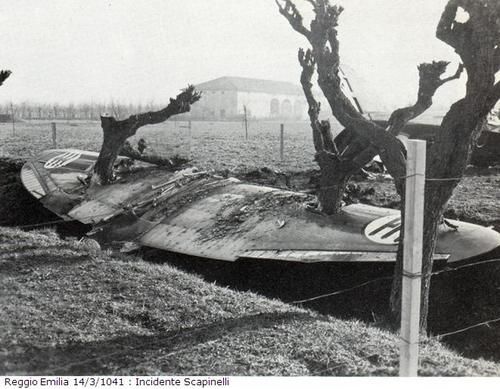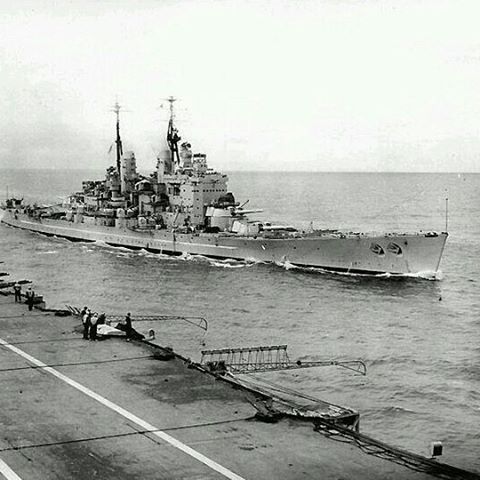Saturday 15 March 1941
 |
| A dead child in Clydebank. This picture of the aftermath of the Clydebank Blitz was censored during the war. On or about 15 March 1941. |
Italian/Greek Campaign: The first phase of the Italian Primavera Offensive ends today, 15 March 1941. At Mussolini's insistence, ground attacks continue, but the main effort now is Italian artillery barrages. The offensive is a failure, but at least it is not a catastrophe like the opening offensive of the war in October, when the Italians not only failed to advance but were forced to retreat ("We are advancing to the rear!"). The Italian lines hold while the Generals bring up reinforcements and plan new attacks. Responding to recent strong Regia Aeronautica activity, the RAF attacks Italian airfields at Berat and Valona.
Mussolini knows by this point that he cannot lose this war because the Wehrmacht is just over the horizon and the weather is improving. However, if he is to regain any semblance of equality with Hitler, Mussolini must pull off some kind of military achievement in the few weeks that remain before the German tide washes over the battlefield. Thus, he has every incentive to throw his men into further pointless battles that wash the mountain crags and gullies with their blood, in the vague hope that suddenly his troops will find some weakness in the Greek lines and turn a disaster into an honorable campaign.
East African Campaign: Lieutenant-General William Platt finally has his forces arranged to attack the Italian strong point of Keren again. At 07:00, the 4th Indian Infantry Division begins attacking from Cameron Ridge, on the left side of Dongolaas Gorge. Their objectives are Sanchil, Brig's Peak, Hog's Back and the three peaks of Mount Sammana - essentially, the heights overlooking the gorge. The main problem for the Indian troops is that there is no cover - they are exposed to Italian fire from above, and often from all sides. Both sides take heavy casualties in this attack. The RAF sends Blenheim and Wellesley bombers over the battlefield, but bombs do little against the rocks and gravel.
On the right side of the Dongolaas Gorge, the 5th Indian Infantry and 2nd Highland Light Infantry also attack. As on the left, the problem for the British is the fact that the Italians have the high ground and can shoot down on soldiers advancing over bare rock. The British forces make little progress on this site, either. However, after dark, the 9th Brigade makes progress and attacks the Pimple and Pinnacle features. After a vicious battle, the Indian troops take the Pinnacle. However, the Italian forces at Fort Dologorodoc remain intact and plan a counterattack in the morning.
While Platt attacks the strong Italian defenses at Keren, he also wants to flank the strong point and cut its lines of communications. The Indian troops of 4/16 Punjab probe the Italian defenses on Engiahat and find them to be very strong. The British bring up artillery for an assault on Engiahat, while a Foreign Legion battalion moves up to occupy Mount Gegghiro and free troops for the assault on Engiahat.
European Air Operations: RAF Bomber Command puts 21 bombers over Dusseldorf. Another 37 aircraft attack the U-boat pens at Lorient.
The Luftwaffe attacks London with 101 bombers, losing two Heinkel He 111s.
Glasgow and Clydebank begin recovering from the Clydebank Blitz of 13-15 March. The authorities later calculate that 528 people have been killed and 617 seriously injured in Clydebank, and 1200 killed and 1100 seriously injured in all of Clydeside. Glasgow is calculated as having about 650 people killed. The massive number of people made homeless in Clydebank are dispersed to surrounding localities.
Battle of the Atlantic: Operating in the Atlantic shipping lanes near the Cape Verde Islands, German heavy cruisers Gneisenau and Scharnhorst only have a few days left to find targets. Scheduled to head to Brest on the 18th, they have little time to find more victims. Normally, a few days at sea in the vast Atlantic would pass without incident, and the ships would make a quick run to the coast. However, Admiral Lütjens gets lucky. With his two tankers trailing him, Lütjens spots a dispersed convoy and decides to go to work.
The bait is tankers and other merchant shipping without an escort. They have been dispersed from Convoy OB 294. Gneisenau captures three and sinks a fourth, while Scharnhorst sinks some ships, too:
It is a nice, easy bag of shipping. The accounts of what happened on which day, the 15th or the 16th, are often muddled. However, these apparently are the ships sunk on the 15th. After putting prize crews on the three tankers and sending them to Bordeaux, the two cruisers of Operation Berlin continue with their attacks on the 16th. The Royal Navy quickly hears about the incident and begins diverting its own ships to the area.Mussolini knows by this point that he cannot lose this war because the Wehrmacht is just over the horizon and the weather is improving. However, if he is to regain any semblance of equality with Hitler, Mussolini must pull off some kind of military achievement in the few weeks that remain before the German tide washes over the battlefield. Thus, he has every incentive to throw his men into further pointless battles that wash the mountain crags and gullies with their blood, in the vague hope that suddenly his troops will find some weakness in the Greek lines and turn a disaster into an honorable campaign.
East African Campaign: Lieutenant-General William Platt finally has his forces arranged to attack the Italian strong point of Keren again. At 07:00, the 4th Indian Infantry Division begins attacking from Cameron Ridge, on the left side of Dongolaas Gorge. Their objectives are Sanchil, Brig's Peak, Hog's Back and the three peaks of Mount Sammana - essentially, the heights overlooking the gorge. The main problem for the Indian troops is that there is no cover - they are exposed to Italian fire from above, and often from all sides. Both sides take heavy casualties in this attack. The RAF sends Blenheim and Wellesley bombers over the battlefield, but bombs do little against the rocks and gravel.
On the right side of the Dongolaas Gorge, the 5th Indian Infantry and 2nd Highland Light Infantry also attack. As on the left, the problem for the British is the fact that the Italians have the high ground and can shoot down on soldiers advancing over bare rock. The British forces make little progress on this site, either. However, after dark, the 9th Brigade makes progress and attacks the Pimple and Pinnacle features. After a vicious battle, the Indian troops take the Pinnacle. However, the Italian forces at Fort Dologorodoc remain intact and plan a counterattack in the morning.
While Platt attacks the strong Italian defenses at Keren, he also wants to flank the strong point and cut its lines of communications. The Indian troops of 4/16 Punjab probe the Italian defenses on Engiahat and find them to be very strong. The British bring up artillery for an assault on Engiahat, while a Foreign Legion battalion moves up to occupy Mount Gegghiro and free troops for the assault on Engiahat.
 |
| The Glasgow Herald reported on the recent heavy Luftwaffe raids on Glasgow and Clydebank, 15 March 1941. |
The Luftwaffe attacks London with 101 bombers, losing two Heinkel He 111s.
Glasgow and Clydebank begin recovering from the Clydebank Blitz of 13-15 March. The authorities later calculate that 528 people have been killed and 617 seriously injured in Clydebank, and 1200 killed and 1100 seriously injured in all of Clydeside. Glasgow is calculated as having about 650 people killed. The massive number of people made homeless in Clydebank are dispersed to surrounding localities.
 |
| "Distribution of people made homeless by the raids who were evacuated from Clydebank, 17 March 1941." National Records of Scotland, ED31/528. |
The bait is tankers and other merchant shipping without an escort. They have been dispersed from Convoy OB 294. Gneisenau captures three and sinks a fourth, while Scharnhorst sinks some ships, too:
- 5688-ton Norwegian tanker Bianca (captured, all survive)
- 8046-ton British tanker San Casmiro (captured, two crew are taken POW on Gneisenau)
- 6405-ton Norwegian tanker Polykarp (captured)
- 4388-ton British freighter Royal Crown (sunk, all survive)
- 4564-ton British freighter Myson (sunk, all survive)
- 4507-ton British freighter Rio Dorado (sunk, all perish)
- 7139-ton British tanker British Strength (sunk, two dead, rest POWs)
- 6554-ton British tanker Athelfoam (two dead, rest POWs)
- 6197-ton British tanker Simnia (sunk, three dead, rest POWs).
German cruiser Admiral Hipper, meanwhile, has been at Brest for a month. It requires a major overhaul in Germany. Taking advantage of the attention drawn by Operation Berlin to the south, the Germans send it on its way during the day. It is bound for the Denmark Strait, then Norway. The British are completely aware of its departure.
German battleship Bismarck continues receiving supplies for its highly anticipated Atlantic raiding expedition. Today, it takes on board its two Arado Ar-196 scout planes at Scheerhafen, Kiel.
The German supply network in the Atlantic remains functional and highly useful for operations. Today, U-124 (Kptlt. Georg-Whilhelm Schulz), operating about 1000 km southwest of the Cape Verde Islands, meets German raider and supply ship Kormoran. The ship wants to give U-124 seven torpedoes and other supplies such as food and fuel. This will enable U-124 to remain at sea when otherwise it would have to return to port. These lengthened voyages are a boon to the U-boat fleet, greatly magnifying its effectiveness. This particular exchange, though, is prevented for the time being by rough seas, so the ships head south looking for tranquility.
U-110 (Kptlt. Fritz-Julius Lemp) spots a convoy south of Iceland. It is Convoy HX-112. Lemp alerts U-boat command, BdU, which begins assembling a Wolf Pack.
The Luftwaffe bombs Royal Navy minesweeper HMS Britomart at Rye Harbour. The ship is only damaged and is towed to Portsmouth, but there are two dead, including skipper Lt. Commander J.M.S. Cox, DSC.
The Luftwaffe bombs Royal Navy monitor HMS Marshall Soult in Portsmouth Harbour. The damage, however, is slight and does not require time out of service.
British 500 ton freighter Eminent hits a mine and sinks in St. George's Channel off Ballywater. Everyone survives.
British 249 ton tug Warrior hits a mine and is damaged at the mouth of the River Cart in the Clyde. The captain beaches the tug at Renfrew. It is later taken to Glasgow for repairs. The incident is a little tricky because the Warrior is towing Norwegian tanker Ferncourt at the time, but Ferncourt is not damaged further.
Royal Navy corvette HMS Bryony, submarine Umbra, minesweeper Sidmouth, anti-submarine trawler Quadrille and minesweeping trawler Rysa are launched, while minesweepers Alarm and Algerine are laid down.
Convoy HG 56 departs from Gibraltar.
U-371 (Oberleutnant zur See Heinrich Driver) is commissioned, U-82, U-433 and U-434 are launched, U-168, U-181, and U-210 are laid down.
 |
| German heavy cruisers Scharnhorst and Gneisenau together, summer 1939. |
Convoy GA.5 departs from Piraeus bound for Alexandria. It has five British and three Greek ships.
The Luftwaffe continues raiding Malta. Most of the attacks are by lone bombers and fighter sweeps. In one of these fighter sweeps, the Bf 109s of 7,/JG 26 shoot down a Wellington bomber arriving from England. In addition, a Hurricane that is scrambled is damaged. The victory is by Staffel leader Oblt. Muncheberg.
Battle of the Indian Ocean: Tug Chabool departs Aden bound for Berbera. It is never seen again. No survivors.
Battle of the Pacific: Convoy ZK-1 departs from Brisbane carrying Australian troops to serve at Port Moresby and Rabaul.
Spy Stuff: At 07:00, the Gestapo arrests journalist Richard C. Hottelet on suspicion of spying in Berlin. The Gestapo takes him to Alexanderplatz as a "guest." As a "guest," he is treated with friendliness and courtesy, but still is fingerprinted, photographed and locked up. He is not told why he has been detained. Hottelet, son of German immigrants to Brooklyn, in fact, is not a spy - at least as far as we know.
Operation Savanna begins. An RAF Whitley bomber drops five SOE-trained Free French paratroopers about eight miles east of Vannes, France. Their mission is to ambush and kill personnel of German Pathfinder formation KG 100. This formation is based at Meucon airfield and, as far as the paratroopers know, commutes by bus from Vannes (where they are billeted) to Meucon. The idea is to destroy the bus and everyone in it. However, the mission is another special-forces fiasco, as the paratroopers find that the Luftwaffe men no longer ride a bus to work, but instead drive there individually. They disperse and make for the coast for pickup.
 |
| Gneisenau sinks the Simnia during Operation Berlin, 15 March 1941. This photo is from the personal album of the radioman on the Gneisenau. Uboatphotos.net. |
Anglo/US Relations: President Roosevelt's latest personal representative to England, Averell Harriman, arrives in London (via Lisbon) and greets Churchill. Harriman knows Churchill since 1927, and they also met at the New York Stock Exchange during the Wall Street Crash of 1929 when Churchill was on a tour of the United States and Canada (Churchill lost a relatively small sum of money in the crash). Harriman tells Churchill that requested war supplies might not necessarily be forthcoming "unless our military chiefs were persuaded that Britain could make better use of the material" than the US military. Thus, "Washington would need a lot more information about Britain's war plans and prospects" because assistance could see a "large increase."
US/Australian Relations: The British and Australian governments agree to a visit to Australia by the cruiser squadron being led by Rear Admiral John H. Newton in USS Chicago. The US cruisers will arrive at Sydney on 20 March 1941.
German Military: As part of the command shuffle before Operation Barbarossa, Field Marshal von Witzleben replace Field Marshal Gerd von Rundstedt as OB West. Von Rundstedt, highly respected by Hitler, is set to command the southern thrust of the German invasion of the Soviet Union.
US Military: Benjamin Kelsey is promoted to major.
German Government: Adolf Hitler has sent Reichsmarschall Hermann Goering to the west for the time being. There is a minor strategic reason for this: Hitler wants the Reichsmarschall's presence there to reinforce among the British the impression that the Wehrmacht still is planning an invasion - when, in fact, Hitler's eyes have drifted in the opposite direction entirely. The Allies will use the same technique in 1944 when they use General George Patton, Jr. as a decoy for the Normandy landings.
Goering has no problem with serving as a decoy. In fact, he revels in it. Going spends his time in Paris, The Hague, and Amsterdam, essentially doing nothing of importance to the war effort. He is not particularly interested in his command, the Luftwaffe, which actually is benefiting from his absence and making some progress in the Blitz with massive raids against smaller cities. Instead, Goering whiles away his days in art galleries, buying marked-down art from Jews nervously looking over their shoulders and hoping that their "assistance" to the Reichsmarschall can get them exit visas to neutral Switzerland.
US Government: President Roosevelt gives a speech to the annual White House Correspondents' Dinner. It is his first speech at the event, which usually is lighthearted and fun. This speech, however, is serious, almost somber. He states:
We know that although Prussian autocracy was bad enough, Hitlerism is far worse. German forces are not seeking mere modifications in colonial maps or in minor European boundaries. They openly seek the destruction of all elective systems of government on every continent-including our own; they seek to establish systems of government based on the regimentation of all human beings by a handful of individual rulers who have seized power by force.He promises, among other things, that the British and Chinese will get what they need to fight aggression, that is, "aid until victory" with no compromise. It is quite a bellicose speech for the leader of a nation that is not at war - at least militarily. The speech is recorded for rebroadcast by the BBC and ultimately is translated into over a dozen languages. He promises "total victory."
Belgium: In Liege, local politicians meet to form the Independence Front resistance group.
 |
| Bomb damage in Birkenhead, Cheshire, 15 March 1941. |
Wirraway A20-132 of 12 Squadron RAAF crashes and bursts into flames at the Adelaide River Railway Station. There are two deaths. The cause of the crash is unexplained, or, as the Australian review board puts it, "obscure." The remains of the crash are on display at the Adelaide River Railway Station Museum.
Portugal: Lisbon has become the clearinghouse of Europe. As referenced in the classic Humphrey Bogart movie "Casablanca," it is the neutral waystation for travel between Occupied Europe and Great Britain or the Americas. Lisbon is a place packed with agents from both sides, one of the few places that German officials and British agents can watch each other directly. While there are other routes out of Europe, Lisbon is the main embarkation point, both by ship and plane. As such, it is a highly desired destination for people hoping to book travel to far-off climes, either permanently or for business or other personal purposes. This demand is putting a tremendous strain on the city's infrastructure, with refugees having to wait long time periods for tickets out or even to find primitive lodgings while they wait.
Today, American Export Lines, one of the main shipping lines able to pass through the blockade being imposed by both sides, announces that it is fully booked for the foreseeable future. It will no longer take reservations.
China: The Japanese have begun a new offensive toward Shanggao, Jiangxi Province, China. Today, the Japanese 11th Army attacks and takes the headquarters of the Chinese 19th Army, occupying Fengshin and heading toward Tucheng and Kaoan. The Chinese launch a vicious airstrike against the Japanese, destroying their supplies of food and ammunition. This slows the Japanese down and gives the Chinese defenders time to dig trenches, build concrete bunkers and form a solid new defensive line. There now are 65,000 Japanese troops facing 100,000 Chinese.
British Homefront: British actress Doris Hare marries Dr. J. Alexander Fraser Roberts at St. Paul's Church, Convent Gardens.
American Homefront: A blizzard hits North Dakota and Minnesota after a day of mild temperatures. It results in about 68 deaths. The storm comes under the category of "Alberta Clippers," which are fast-moving storms of brief duration.
Glenn Miller and his Orchestra continue their dominance of the brand new Billboard singles chart. "The Song of the Volga Boatmen" hits No. 1 and becomes one of the year's top ten singles.
Future History: Michael Edward Love is born in Baldwin Hills, Los Angeles, California. Mike begins playing the saxophone. He and some neighborhood boys form the Pendletones, playing in their garages. The group switches lead vocals, but Mike Love is the central go-to singer. Love also begins writing songs for the group to sing. The group eventually changes its name to the Beach Boys, and they embark on a string of classic pop tunes. The Beach Boys hit what many consider to be their peak in the mid-sixties with "Pet Sounds" and "Smile," but their career spans many decades and continues to this day. Mike Love continues to make music, much of it unreleased, and he has said (in 2013) "I've stockpiled these things for decades now, but we finally have a team to get my music out." Mike Love published his autobiography, "Good Vibrations: My Life as a Beach Boy," on 13 September 2016.
 |
| A casualty of the 15 March 1941 blizzard. Many deaths were caused by cars becoming immobilized, like this one, and the occupants abandoning them to try to walk to town or home. |
March 1941
March 1, 1941: Rettungsboje
March 2, 1941: Oath of Kufra
March 3, 1941: Germans in Bulgaria
March 4, 1941: Lofoten Islands Raid
March 5, 1941: Cooperation With Japan
March 6, 1941: Battle of Atlantic
March 7, 1941: Prien Goes Under
March 8, 1941: Cafe de Paris
March 9, 1941: Italian Spring Offensive
March 10, 1941: Humanitarian Aid
March 11, 1941: Lend Lease Become Law
March 12, 1941: A New Magna Carta
March 13, 1941: Clydeside Wrecked
March 14, 1941: Leeds Blitz
March 15, 1941: Cruisers Strike!
March 16, 1941: Kretschmer Attacks
March 17, 1941: Happy Time Ends
March 18, 1941: Woolton Pie
March 19, 1941: London Hit Hard
March 20, 1941: Romeo and Juliet
March 21, 1941: Plymouth Blitz
March 22, 1941: Grand Coulee Dam
March 23, 1941: Malta Under Siege
March 24, 1941: Afrika Korps Strikes!
March 25, 1941: Yugoslavia Joins The Party
March 26, 1941: Barchini Esplosivi
March 27, 1941: Belgrade Coup
March 28, 1941: Cape Matapan Battle
March 29, 1941: Lindbergh Rants
March 30, 1941: Commissar Order
March 31, 1941: Cookie Bombs
2020
March 1, 1941: Rettungsboje
March 2, 1941: Oath of Kufra
March 3, 1941: Germans in Bulgaria
March 4, 1941: Lofoten Islands Raid
March 5, 1941: Cooperation With Japan
March 6, 1941: Battle of Atlantic
March 7, 1941: Prien Goes Under
March 8, 1941: Cafe de Paris
March 9, 1941: Italian Spring Offensive
March 10, 1941: Humanitarian Aid
March 11, 1941: Lend Lease Become Law
March 12, 1941: A New Magna Carta
March 13, 1941: Clydeside Wrecked
March 14, 1941: Leeds Blitz
March 15, 1941: Cruisers Strike!
March 16, 1941: Kretschmer Attacks
March 17, 1941: Happy Time Ends
March 18, 1941: Woolton Pie
March 19, 1941: London Hit Hard
March 20, 1941: Romeo and Juliet
March 21, 1941: Plymouth Blitz
March 22, 1941: Grand Coulee Dam
March 23, 1941: Malta Under Siege
March 24, 1941: Afrika Korps Strikes!
March 25, 1941: Yugoslavia Joins The Party
March 26, 1941: Barchini Esplosivi
March 27, 1941: Belgrade Coup
March 28, 1941: Cape Matapan Battle
March 29, 1941: Lindbergh Rants
March 30, 1941: Commissar Order
March 31, 1941: Cookie Bombs
2020





